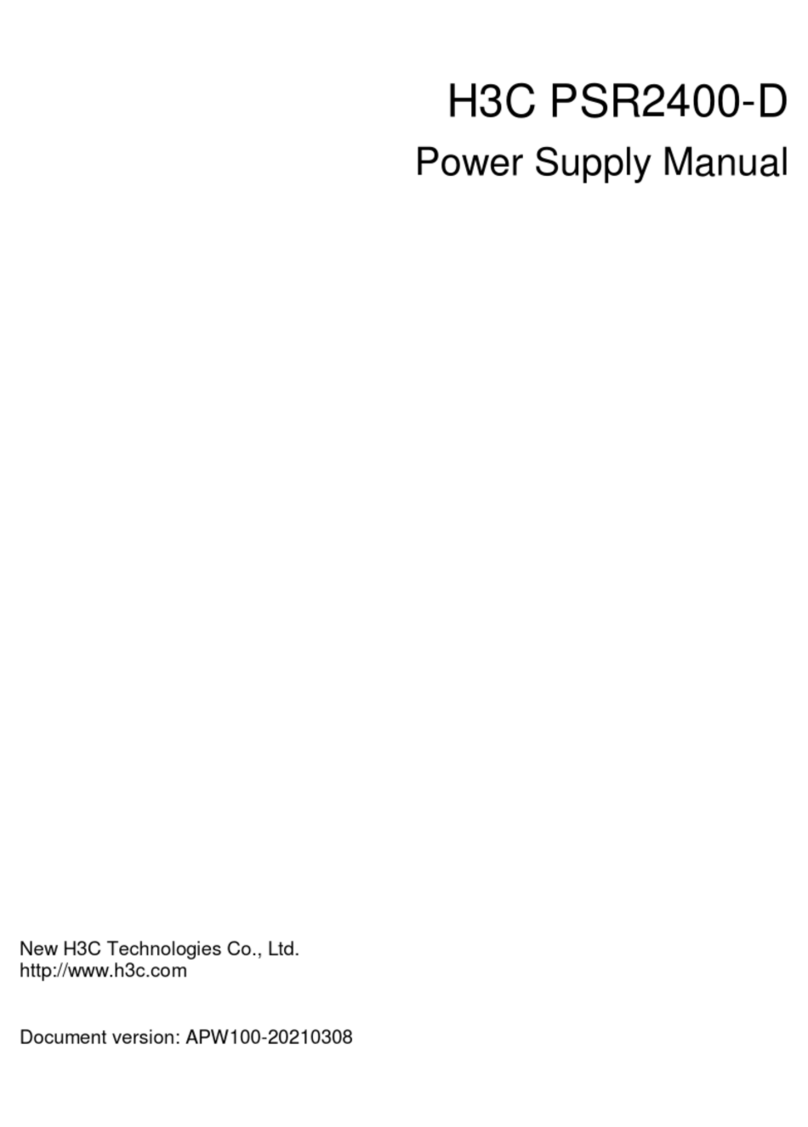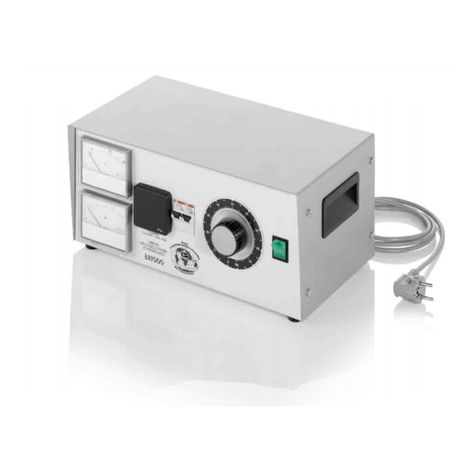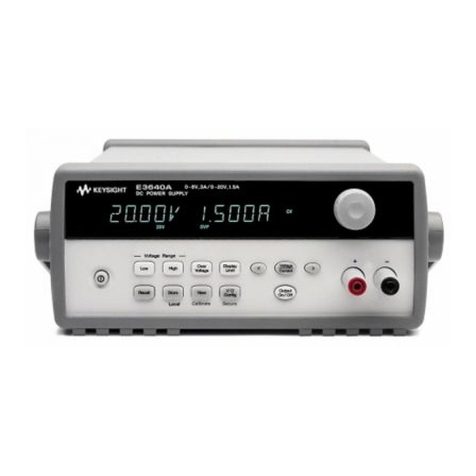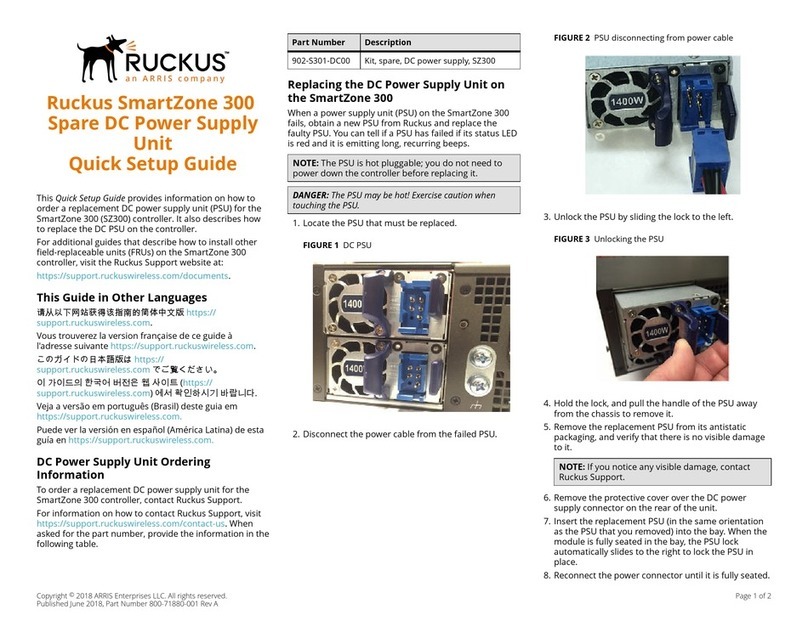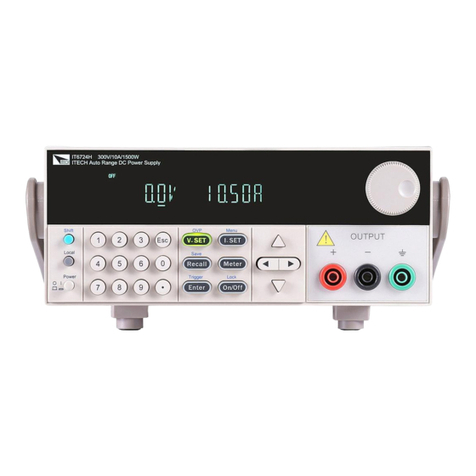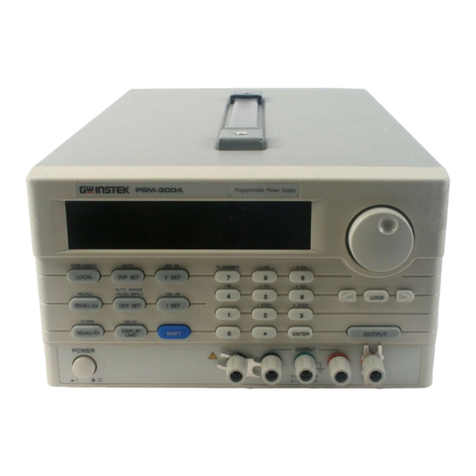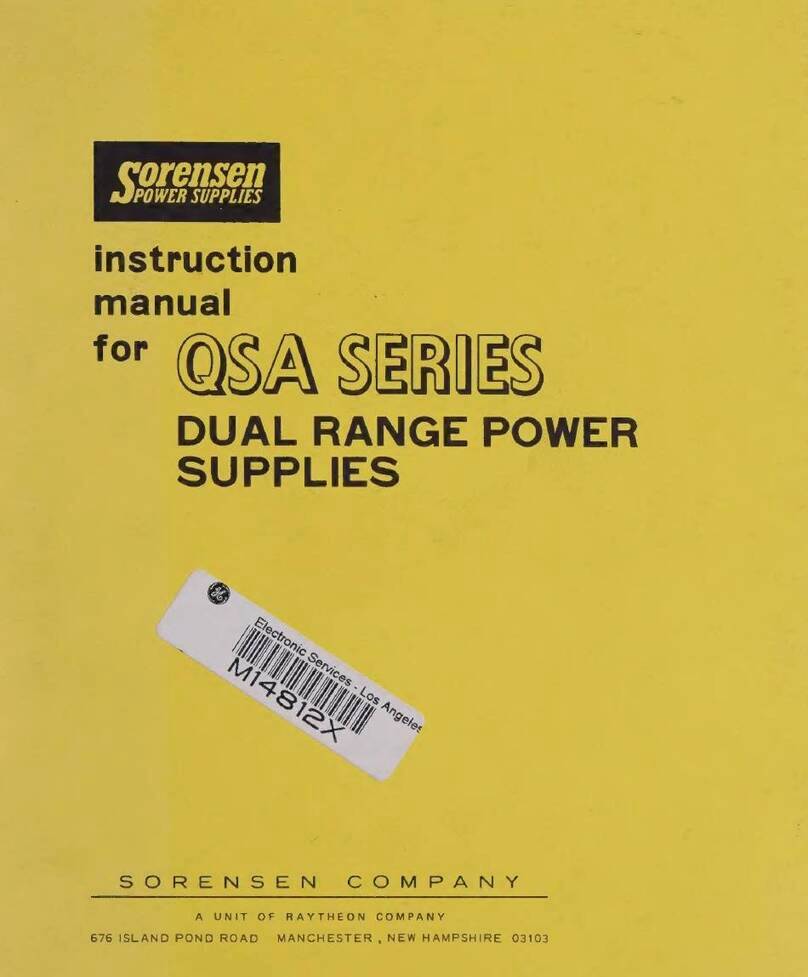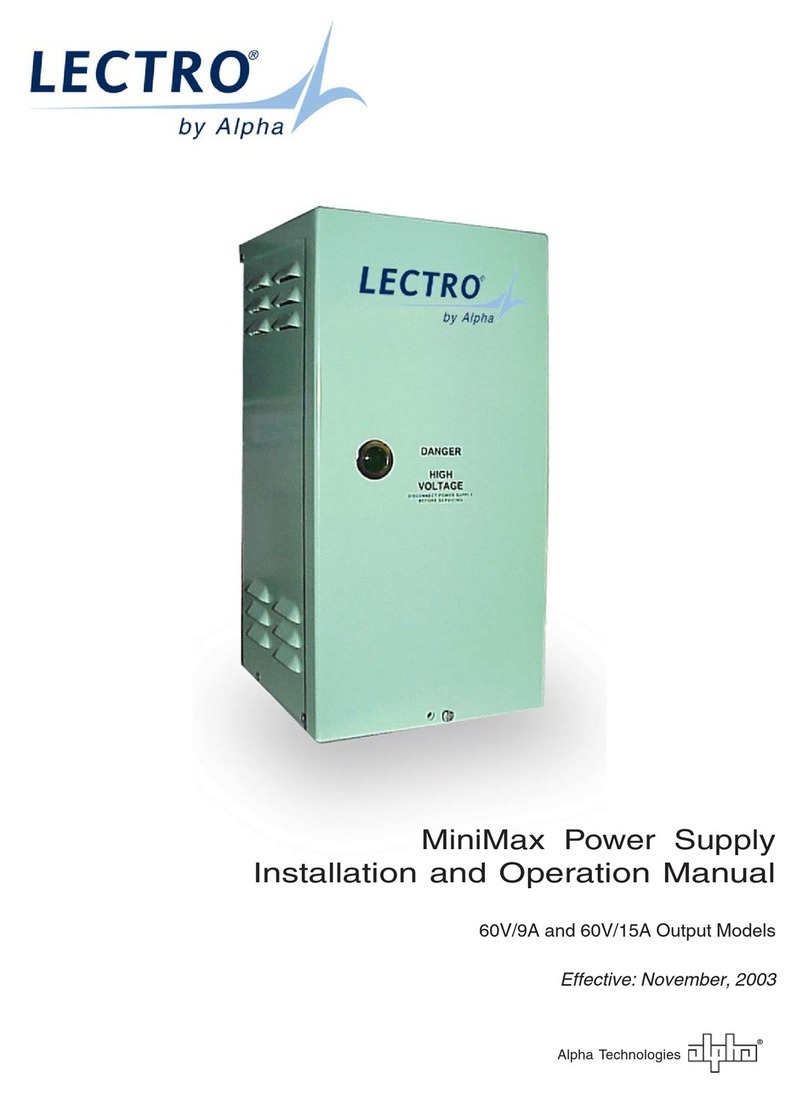Tri-M HESC-UPS Use and care manual

HESC-UPS Manual
High Efficiency & Smart Charging
Uninterruptible Power Supply
Firmware Manual
For HESC products featuring
Microchip PIC16F microprocessors
Designed by
TRI-M ENGINEERING
Engineered Solutions for Embedded Applications
Technical Manual
P/N: HESC-UPS
For firmware Rev 2.24 or higher.
Revision: 18/09/03
Unit 100, 1407 Kebet Way
Port Coquitlam, British Columbia, V3C 6L3
Canada
http://www.Tri-M.com
Tel 604.945.9565 - North America 800.665.5600
Fax 604.945.956

18/09/2003 HESC-UPS Manual
Tri-M Engineering Tel: 800.665.5600, 604.945.9565
1407 Kebet Way, Unit 100 Fax: 604.945.95
Canada Web site: www.tri-m.com
2
PREFACE
This manual is for integrators of applications of embedded systems. It contains information on hardware and software
requirements and interconnection to other embedded electronics.
DISCLAIMER
Tri-M Engineering makes no representations or warranties with respect to the contents of this manual, and specifically
disclaims any implied warranties of merchantability or fitness for any particular purpose. Tri-M Engineering shall under no
circumstances be liable for incidental or consequential damages or related expenses resulting from the use of this
product, even if it has been notified of the possibility of such damages. Tri-M Engineering reserves the right to revise this
publication from time to time without obligation to notify any person of such revisions. If errors are found, please contact
Tri-M Engineering at the address listed on the title page of this document.
COPYRIGHT © 2003-08-12 TRI-M ENGINEERING
No part of this document may be reproduced, transmitted, transcribed, stored in a retrieval system, or translated into any
language or computer language, in any form or by any means, electronic, mechanical, magnetic, optical, chemical,
manual, or otherwise, without the express written permission of Tri-M Engineering.

18/09/2003 HESC-UPS Manual
Tri-M Engineering Tel: 800.665.5600, 604.945.9565
1407 Kebet Way, Unit 100 Fax: 604.945.95
Canada Web site: www.tri-m.com
3
Table of Contents
Section 1 : HESC Overview....................................................................................................................................................5
Section 2 : Start-up and Shut-down settings, delays, and functions.......................................................................................5
Section 3 : HESC-SER SerBus Communications...................................................................................................................7
A. Description: .....................................................................................................................................................................7
B. Slave Mode:....................................................................................................................................................................7
Section 4 : HESC104 PC/104 Bus Communications..............................................................................................................8
A. Description: .....................................................................................................................................................................8
B. Slave Mode:....................................................................................................................................................................8
Section 5 : HESC I2C/SMBus Bus Communications ..............................................................................................................9
A. Description: .....................................................................................................................................................................9
Section 6 SerBus, SMBus, and PC/104 Command Functions...............................................................................................9
A. List of Command Functions ............................................................................................................................................9
B. HESC Function Command Details................................................................................................................................11
1. BattTempCmd() 0x08..........................................................................................................................................11
2. BattVCmd() 0x09.................................................................................................................................................11
3. BattICmd() 0x0A..................................................................................................................................................11
4. BattIavgCmd() 0x0B............................................................................................................................................12
5. BattRemCapCmd() 0x0F ....................................................................................................................................12
6. ChargerSpecInfoCmd() 0x11..............................................................................................................................12
7. ChargerModeCmd() 0x12...................................................................................................................................13
8. ChargerStatusCmd() 0x13..................................................................................................................................13
9. ChargingCurrentCmd() 0x14...............................................................................................................................15
10. ChargingVoltageCmd() 0x15 ..............................................................................................................................16
11. AlarmWarningCmd() 0x16 ..................................................................................................................................16
12. GetVersionCmd() (0x3E) ....................................................................................................................................17
13. SerialNumber() (0x3F) ........................................................................................................................................17
14. GetI2CTempCmd0() (0x80) to GetI2CTempCmd15() (0x8F).............................................................................17
15. TempThCmd() (0x90)..........................................................................................................................................17
16. MainVCmd() (0x91).............................................................................................................................................18
17. MainICmd() (0x92)..............................................................................................................................................18
18. InputPwrCmd() (0x93).........................................................................................................................................18
19. BattPwrCmd() (0x94) ..........................................................................................................................................18
20. ChCycleCmd() (0x95) .........................................................................................................................................19
21. ChTermLastCmd() (0x96)...................................................................................................................................19
22. ShutDownCmd() (0x97) ......................................................................................................................................19
23. PowerSupplyStatusCmd() (0x98) .......................................................................................................................20
24. SDSUCauseCmd() (0x99) ..................................................................................................................................21
25. ActiveEEcmd() (0xA0)........................................................................................................................................21
26. EEPromCmd () (0xA1).......................................................................................................................................22
Section 7 : EEprom Setpoints and Configuration Variables .................................................................................................23
A. List of EEprom Setpoints and Configuration Variable...................................................................................................23
B. SerBus EEprom Details ................................................................................................................................................25
1. ChTerm - EEprom Locations 0x00, 0x20, 0x40, 0x60:.......................................................................................25
2. Spare - EEprom Locations 0x02 0x22 0x42 0x62 ..............................................................................................25
3. Spare - EEprom Locations 0x04 0x24 0x44 0x64 ..............................................................................................25
4. BattVmaxDef - EEprom Locations 0x06, 0x26, 0x46, 0x66:...............................................................................25
5. BattVmaxTimeDef - EEprom Locations 0x08, 0x28, 0x48, 0x68:.......................................................................26
6. BattVdeltaDef - EEprom Locations 0x0A, 0x2A, 0x4A, 0x6A:............................................................................26
7. TimeMaxDef - EEprom Locations 0x0C, 0x2C, 0x4C, 0x6C:.............................................................................26
8. BattIminDef - EEprom Locations 0x0E, 0x2E, 0x4E, 0x6E:................................................................................26
9. BattImaxDef - EEprom Locations 0x10, 0x30, 0x50, 0x70:................................................................................26
17. ChFlags - EEprom Locations 0x80;....................................................................................................................27
18. BattLowVoltageDef – EEprom Locations 0x82...................................................................................................27
19. BattLowCapacityDef – EEprom Locations 0x82.................................................................................................27

18/09/2003 HESC-UPS Manual
Tri-M Engineering Tel: 800.665.5600, 604.945.9565
1407 Kebet Way, Unit 100 Fax: 604.945.95
Canada Web site: www.tri-m.com
4
20. BattTempMinDef - EEprom Locations 0x8A:......................................................................................................27
21. BattTempMaxDef - EEprom Locations 8C:.........................................................................................................28
22. BattVminDef - EEprom Locations 0x8E:.............................................................................................................28
23. PWRSDdebDef (0xD0), PWRSUdebDef (0xD2), IGNSDdebDef (0xD8), IGNSUdebDef (0xDA)......................28
24. PWRSDDef (0xD4), IGNSDDef (0xDC), PBSDDef (0xE0), BATTSDDef (0xE4), Cmd98SDDef (0xE6)...........28
25. PWRSUDef (0xD6), IGNSUDef (0xDE), PBSUDef (0xE2), Cmd98SUDef (0xE8).............................................28
Section 8 : Temperature Sensor, TS-IC and Controller, TC-IC............................................................................................29
Section 9 : Battery Charging Algorithms and Strategies.......................................................................................................30
A. Sealed Lead Acid, SLA.................................................................................................................................................30
1. Single Stage Charging........................................................................................................................................30
2. Dual Stage Charging...........................................................................................................................................30
Section 10 HESC-UPS FIRMWARE UPDATE PROCEDURE.............................................................................................32
Section 11 : Implementing a smart “Watchdog Timer” on the Host CPU .............................................................................33
Table 1, List of HESC Command Functions.........................................................................................................................10
Table 2, ChargerSpecInfoCmd bit map ................................................................................................................................12
Table 3, ChargerModeCmd bit map......................................................................................................................................13
Table 4, ChargerStatusCmd bit map ....................................................................................................................................14
Table 5, ChTermLastCmd bit map........................................................................................................................................19
Table 6, PowerSupplyStatusCmd bit map............................................................................................................................20
Table 7, SDSUCauseCmd bit map .......................................................................................................................................21
Table 8, HESC Setpoints and Configuration Variables ........................................................................................................23
Table 9, ChTerm bit map ......................................................................................................................................................25
Table 10, ChFlags bit map....................................................................................................................................................27
Table 11, Temperature Sensor and Temperature Controller bit map...................................................................................29
Table 12, SLA Single Stage Charging Set-up.......................................................................................................................30
Table 13, SLA Two Stage Charging Set-up..........................................................................................................................31

18/09/2003 HESC-UPS Manual
Tri-M Engineering Tel: 800.665.5600, 604.945.9565
1407 Kebet Way, Unit 100 Fax: 604.945.95
Canada Web site: www.tri-m.com
5
Section 1 : HESC Overview
The High Efficiency & Smart Charging (HESC) product line includes the HESC-SER and HESC104. Command, control,
monitoring and datalogging via the SMBus are the same for both the HESC-SER and HESC104. However, the HESC-
SER also has an RS232 serial port and the HESC104 has a PC/104 bus interface. The serial port and PC/104 bus
interface are in most instances connected only to the Host CPU, however other devices may also make use of these
ports. For example, it is possible that a battery pack could be built with an RS232 serial port and it could be connected to
the HESC-SER serial port.
Throughout this manual, use of the term HESC refers to any of the HESC products, while use of the name HESC-SER or
HESC104 refers strictly to a particular product. From the command function point of view, there are few differences
between the HESC-SER and the HESC104 even though they have different Host interfaces (the SMBus is usually thought
of as a battery interface, but it may also interface with a Host CPU or a microcontroller). Whenever there are any
differences in the commands functions for the different HESC models, they will be noted in the command function
description.
The HESC can be set-up to provide up to four stages of charging for standard battery packs. Changing from one cycle to
the next is accomplished by setting the charge termination flags and values. When one of the charge termination
methods is satisfied, the next charging stage values are retrieved from the EEprom. If the current cycle is the last cycle
enabled, then charging will be terminated. Additionally, the Host can directly command the HESC to change charging
cycles.
Section 2 : Start-up and Shut-down settings, delays, and functions
The HESC-UPS firmware power management system works well with advanced operating systems such as Windows,
and Linux. It is imperative with the advanced operating systems that an orderly shutdown of the files be down of the
application program and operating system. Failure to allow for orderly shutdown can cause data loss, intermittent
crashes, or a complete unrecoverable system failure.
The HESC-UPS firmware has three internal modes that control the start up and shut down of the HESC outputs.
1. Debounce
HESC-UPS firmware "debounces" the main power and the IGN input start up and shut down requests by requiring the
cause of the request to remain valid for the debounce interval. There is separate shut down and start up debounce
definitions for both main power and the IGN input. The debounce time can be set from zero to 65535 seconds. The
HESC-UPS provide this debouncing to prevent nuisance shut downs or start-ups.
2. Start-Up
The HESC-UPS firmware sets the Start-Up request flag, and begins the Start-Up mode after receiving a start up
request. (The Start-Up request flag can be read with PowerSupplyStatusCmd.) The Start-Up mode is initiated by
loading the Start-Up timer with the Start-Up interval assigned to the Start-Up request cause. If the HESC is already in
Start-Up mode when a new Start-Up request is received, the Start-Up timer will be loaded with the new Start-Up
interval if it is less than the existing Start-Up timer count. When the Start-Up timer expires, the HESC outputs are
turned on. During Start-Up mode, the CPU LED will blink rapidly (2 Hz). If a Shut-Down request is received while a
Start-Up request is active, the current active Start-Up request will be cancelled.
Start-Up requests are generated by:
o When the HESC has main power applied.
o When the IGN input of the HESC-SER is taken to the "On" state. The polarity of the IGN is programmable,
so the state of the input (high or low) will depend on the polarity setting.
o When the SD input of the HESC104 is taken to the "On" state. The polarity of the SD is programmable, so
the state of the input (high or low) will depend on the polarity setting.
o When the Pushbutton Shutdown (SD) input is energized, and the HESC-SER is off or is in the shutdown
mode.
o When the Pushbutton Shutdown (PS) input is pulled to Common, and the HESC104 is off or is in the
shutdown mode.

18/09/2003 HESC-UPS Manual
Tri-M Engineering Tel: 800.665.5600, 604.945.9565
1407 Kebet Way, Unit 100 Fax: 604.945.95
Canada Web site: www.tri-m.com
6
o When the Host CPU writes command PowerSupplyStatusCmd with bit 7 set, either through the SerBus,
PC/104 bus or the I2C/SMBus.
Note: Setting a shut down interval to zero prevents Shut-Down request being issued from it's cause.
3. Shut-Down
The HESC-UPS firmware sets the Shut-Down request flag, and begins the Shut-Down mode after receiving a shut
down request. (The Shut-Down request flag can be read with PowerSupplyStatusCmd.) The Shut-Down mode begins
by loading the Shut-Down timer with the Shut-Down interval assigned to the Shut-Down request cause. If the HESC
is already in Shut-Down mode when a new Shut-Down request is received, the Shut-Down timer will be loaded with
the new Shut-Down interval if it is less than the existing Shut-Down timer count. When the Shut-Down timer expires,
the HESC outputs are turned off. During Shut-Down mode, the CPU LED will blink slowly (0.5 Hz). ). If a Start-Up
request is received while a Shut-Down request is active, the Start-Up request will be "registered" and take effect after
the Shut-Down mode is complete. The only method to cancel a Shut-Down mode in progress is by a Host CPU using
command PowerSupplyStatusCmd with bit 8 cleared.
Shut-Down requests are generated by:
o When the HESC main power is removed.
o When the IGN input of the HESC-SER is taken to the "Off" state. The polarity of the IGN is programmable,
so the state of the input (high or low) will depend on the polarity setting.
o When the SD input of the HESC104 is taken to the "Off" state. The polarity of the IGN is programmable, so
the state of the input (high or low) will depend on the polarity setting.
o When the Pushbutton Shutdown (SD) input is energized, and the HESC-SER is on.
o When the Pushbutton Shutdown (PS) input is pulled to Common, and the HESC104 is on.
o When the Host CPU writes command PowerSupplyStatusCmd with bit 8 set, either through the SerBus,
PC/104 bus or the I2C/SMBus.
o When the Host CPU writes command ShutDownCmd to the HESC through the SerBus, PC/104 bus or the
I2C/SMBus.
o When the battery voltage or battery capacity falls below the BattLowVoltageDef or BattLowCapacityDef
levels.
Note: Setting a shut down interval to zero prevents a Shut-Down request being issued.
Feature: Writing command PowerSupplyStatusCmd with bits 7 & 8 set will result in the HESC turning off the outputs after
the Shut-Down interval, and turning on the outputs after the Start-Up interval. This is useful for remote data logging
systems that only need to be on for brief intervals, then turned back off to conserve power.

18/09/2003 HESC-UPS Manual
Tri-M Engineering Tel: 800.665.5600, 604.945.9565
1407 Kebet Way, Unit 100 Fax: 604.945.95
Canada Web site: www.tri-m.com
7
Section 3 : HESC-SER SerBus Communications
A. Description:
The HESC-SER communicates with the Host through the asynchronous serial bus. Commands and data are sent and
received using a full duplex 8 bit, no parity, 9600 baud, and one stop bit format. The HESC-SER operates in a "slave"
mode where the Host initiates all the communications between the HESC-SER and the Host.
- Table 1 lists the commands the HESC supports.
To ensure reliable communication, an acknowledge byte is returned after each address, command or data byte
transmitted. The receiving device (HESC-SER or Host) must acknowledge receipt of each byte, unless the bus timer is
turned off. If an acknowledge byte doesn't match the acknowledge number expected then a "collision" is deemed to have
occurred. The transaction is aborted immediately and the result byte set accordingly.
An "enhanced" communication mode is available by adding an optional checksum value. If the HESC-SER receives a
Read command from the Host with the acknowledge set to 0x03 after sending [databyteR high], it will switch to enhanced
mode for all future communications. Communication will return to non-checksum mode when the Host CPU sends an
acknowledge 0xFF after [databyteR high].
B. Slave Mode:
1. Commands received from the Host and data sent to or received from the to Host CPU over the SerBus. The
transaction is invalid and commands/data are not to be used until:
- the final acknowledge 0xFF is received
- the checksum matches the transmitted data (checksum is optional, but if sent must be used)
2. Note: Read and Write is defined as the action the command places on the HESC-SER RAM and EEprom. Therefore,
Read and Write have the same meaning for Master and Slave modes:
3a. Write command without checksum acknowledge.
HOST: <addressW> <command> <databyteW low > <databyteW high >
HESC-SER: [0x00] [0x01] [0x02] [0xFF]
3b. Write command with checksum acknowledge.
HOST: <addressW> <command> <databyteW low > <databyteW high > <checksum>
HESC-SER: [0x00] [0x01] [0x02] [0x03] [0xFF]
3c. Write command without checksum acknowledge and without bus timer enabled.
HOST: <addressW> <command> <databyteW low > <databyteW high >
HESC-SER: [0x00]** [0x01]** [0x02]** [0xFF]**
4a. Read command without checksum acknowledge.
HOST: <addressR> <command> <0x02> <0xFF>
HESC-SER: [0x00] [databyteR low] [databyteR high]
4b. Read command with checksum acknowledge.
HOST: <addressR> <command> <0x02> <0x03> <0xFF>
HESC-SER: [0x00] [databyteR low] [databyteR high] [checksum]
4c. Read command without checksum acknowledge and without bus timer enabled.
HOST: <addressR> <command>
HESC-SER: [0x00]** [databyteR low] [databyteR high]
**{HOST does not need to wait for Ack from HESC-SER}

18/09/2003 HESC-UPS Manual
Tri-M Engineering Tel: 800.665.5600, 604.945.9565
1407 Kebet Way, Unit 100 Fax: 604.945.95
Canada Web site: www.tri-m.com
8
where "host" addressW = 0001 001 + 0 (R/W bit) = 0x12
"host" addressR = 0001 001 + 1 (R/W bit) = 0x13
The checksum is a two digit hexadecimal checksum that is the two's complement of the sum of all preceding
bytes. For example the data <0x10> <0x12> <0xC0> <0x03> has the checksum 0x1B.
Section 4 : HESC104 PC/104 Bus Communications
A. Description:
The HESC104 communicates with the Host through the PC/104 bus. Commands and data are sent and received using a
8 bit, I/O memory mapped I/O address. The address lines A0 to A9, & AEN are decoded to provide four addresses that
are jumper selectable. An I/O write to the decoded address will "strobe" the data into the HESC, and an I/O read will read
the data from the HESC104. Whenever the HESC104 has data in it's output port that requires the Host CPU to perform
an I/O read, it generates a PC/104 bus interrupt (IRQ5 or IRQ7, see section on setting jumpers). The PC/104 bus
interrupt is removed after an I/O read from the HESC104. The HESC104 operates in a "slave" mode where the Host
initiates all the communications between the HESC104 and the Host.
- Table 1 lists the commands the HESC supports.
To ensure reliable communication, an acknowledge byte is returned after each address, command or data byte
transmitted. The receiving device (HESC104 or Host) must acknowledge receipt of each byte. This is true even if the bus
timer is turned off. (The HESC104 and HESC-SER differ in that if the HESC-SER bus timer is off an acknowledge byte is
not issued.) If an acknowledge byte doesn't match the acknowledge number expected then a "collision" is deemed to have
occurred. The transaction is aborted immediately and the result byte set accordingly.
An "enhanced" communication mode is available by adding an optional checksum value. If the HESC104 receives a
Read command from the Host with the acknowledge set to 0x03 after sending [databyteR high], it will switch to enhanced
mode for all future communications. Communication will return to non-checksum mode when the Host CPU sends an
acknowledge 0xFF after [databyteR high].
B. Slave Mode:
1. Commands received from the Host and data sent to or received from the to Host CPU over the PC/104 bus. The
transaction is invalid and commands/data are not to be used until:
- the final acknowledge 0xFF is received
- the checksum matches the transmitted data (checksum is optional, but if sent must be used)
2. Note: Read and Write is defined as the action the command places on the HESC104's RAM and EEprom. Therefore,
Read and Write have the same meaning for Master and Slave modes:
3a. Write command without checksum acknowledge.
HOST: <addressW> <command> <databyteW low > <databyteW high >
HESC104: [0x00] [0x01] [0x02] [0xFF]
3b. Write command with checksum acknowledge.
HOST: <addressW> <command> <databyteW low > <databyteW high > <checksum>
HESC104: [0x00] [0x01] [0x02] [0x03] [0xFF]
4a. Read command without checksum acknowledge.
HOST: <addressR> <command> <0x02> <0xFF>
HESC104: [0x00] [databyteR low] [databyteR high]

18/09/2003 HESC-UPS Manual
Tri-M Engineering Tel: 800.665.5600, 604.945.9565
1407 Kebet Way, Unit 100 Fax: 604.945.95
Canada Web site: www.tri-m.com
9
4b. Read command with checksum acknowledge.
HOST: <addressR> <command> <0x02> <0x03> <0xFF>
HESC104: [0x00] [databyteR low] [databyteR high] [checksum]
where "host" addressW = 0001 001 + 0 (R/W bit) = 0x12
"host" addressR = 0001 001 + 1 (R/W bit) = 0x13
The checksum is a two digit hexadecimal checksum that is the two's complement of the sum of all preceding bytes. For
example the data <0x10> <0x12> <0xC0> <0x03> has the checksum 0x1B.
Section 5 : HESC I2C/SMBus Bus Communications
A. Description:
The HESC can communicate with System Management Bus (SMBus) batteries, I2C digital temperature sensors, and
Hosts and microprocessors through the I2C/SMBus. The SMBus is a two-wire interface through which the HESC can
communicate to I2C/SMBus devices. The HESC supports I2C/SMBus multi-master bus capability, meaning that other
devices capable of controlling the bus can be connected to it. The HESC transfers data by one I2C/SMBus device acting
as a master, and another I2C/SMBus device acting as a slave (with one of the devices being the HESC). A master device
initiates a bus transfer and provides the clock signals (SCL). A slave device can receive data (SDA) provided by the
master or it can provide data to the master. Since more than one device may attempt to take control of the bus as a
master, I2C/SMBus provides an arbitration mechanism, relying on the wired-AND connection of all I2C/SMBus interfaces
to the I2C/SMBus.
NOTE: Care should be taken in the design of both the input and output stages of SMBus devices, in order
not to load the bus when their power plane is turned off.
The HESC uses the master to alert the Host of a change in status or of alarm in the HESC. The HESC alerts the Host by
sending the ChargerStatus() value. This occurs when main power is applied or removed, battery pack inserted/removed,
battery fully charged or fully discharge, shutdown activated or de-activated, or temperature alarm. When the HESC
alerts the Host, the HESC places its address 0x12 in the command byte. The HESC alert communications format would
then appear as 0x10, 0x12, datalow, datahigh.
- Table 1 lists the commands the HESC I2C/SMBus supports.
To ensure reliable communication, an acknowledge bit is returned after each address, command or data byte transmitted.
The receiving device must acknowledge receipt of each byte. If an acknowledge bit is not received then the transfer is
aborted immediately and the result byte set accordingly.
Section 6 SerBus, SMBus, and PC/104 Command Functions
A. List of Command Functions
1. The SerBus and PC/104 Bus command functions are similar to many of the SMBus command functions. Where
possible, the functions are the same as the SMBus functions. The following table list the HESC command functions,
access, units and range of the data.
2. There are two types of command functions, RAM and EEprom. RAM variables are used to actively monitor and
control the HESC. However, RAM is volatile memory and loses it contents on power loss. The EEprom is used to
store setpoints and configuration for the HESC. Separate functions allow easy access to the RAM variables.

18/09/2003 HESC-UPS Manual
Tri-M Engineering Tel: 800.665.5600, 604.945.9565
1407 Kebet Way, Unit 100 Fax: 604.945.95
Canada Web site: www.tri-m.com
10
3. Since setting up the HESC is only done infrequently, only two commands are provided. Function ActiveEEcmd()
sets the location for the next EEprom read or write, and if the location should auto increment. Function EEPromCmd()
reads or writes the EEprom location as set by ActiveEEcmd().
Table 1, List of HESC Command Functions
Code Command Function
SerBus
SMBus
PC/104
Access
Units Range Description
0x08 BattTempCmd() 999R 0.1K * 0 to 6553.5 Read battery temperature
0x09 BattVCmd() 999R mV 0 to 65535 Read battery voltage
0x0A BattICmd() 999R mA 0 to 32767
0 to -32768 Read battery current
0x0B BattIavgCmd() 999R mA 0 to 32767
0 to -32768 Read 1 minute rolling average battery current
0x0F BattRemCapCmd() 999R mAh or 10mWh
** 0 to 65535 Read remaining battery capacity
0x11 ChargerSpecInfoCmd() 999R Bit flags N/A Read SMBus specification compatibility
0x12 ChargerModeCmd() 999W Bit flags N/A Set Charger Mode
0x13 ChargerStatusCmd() 999R Bit flags N/A Read charger status
0x14 ChargingCurrentCmd() 999R/W mV 0 to 65535 Read battery charging voltage setpoint
0x15 ChargingVoltageCmd() 999R/W mA 0 to 65535 Read battery charging current setpoint
0x16 AlarmWarningCmd() 999R/W Bit flags N/A Alarm Notification
0x3E GetVersionCmd() 991 9R High/Low byte*** N/A Read charger firmware revision
0x3F GetChSerNumCmd() 991 9R 8 byte N/A Read charger serial number
0x80 GetI2CtempCmd0() 992 9R 0.1K * 0 to 6553.5 Read I2C temperature
to
0x8F GetI2CtempCmd15() 992 9R 0.1K * 0 to 6553.5 Read I2C temperature
0x90 TempThCmd() 992 9R Word 0 to 65535 Read TH (thermistor) value
0x91 MainVCmd() 992 9R mV 0 to 65535 Read main input voltage
0x92 MainICmd() +
9
92 9R mA 0 to 65535 Read input current
0x93 InputPwrCmd() 992 9R 10mW 0 to 65535 Read input power
0x94 BattPwrCmd() 992 9R 10mW 0 to 65535 Read charging power
0x95 ChCycleCmd() 992 9R/W integer 0 to 3 Read/Set charging cycle
0x96 ChTermLastCmd() 992 9R Bitflags N/A Read last termination method
0x97 ShutDownCmd() 992 9R/W sec 0 to 65535
A
write will shut down the power suppl
y
in X
seconds. A read will return time left until shutdown.
Use command PowerSuppl
y
StatusCmd
()
to
determine if a shutdown is in progress.
0x98 PowerSupplyStatusCmd() 992 9R/W Bitflags N/A Read/Write power supply flags
0x99 SDSUCauseCmd() 992 9R Bitflags N/A Read cause of SD and SU requests
0x9A I2CLowAlarmsCmd 992 9R Bitflags N/A
0x9B I2CHighAlarmsCmd 992 9R Bitflags N/A
0xA0 ActiveEEcmd() 992 9R/W byte.byte **** Read/Set active EEprom location and auto increment
0xA1 EEPromCmd() 992 9R/W Word 0 to 65535 Read/Write value to active EEprom location
91 SMBus Optional Manufacturer Functions
92 Function not defined by SMBus standards
* 0 degress Kelvin = -273.2C
** The BattRemCapCmd() capacity value is expressed in either current (mAh at a C/5 discharge rate) or power (10mWh at a
P/5 discharge rate) depending on the setting of the capacity mode bit.
*** High byte = major version, Low byte = minor version
**** Low byte = location 0 to 127, High byte: no auto increment = 0; auto increment = 1

18/09/2003 HESC-UPS Manual
Tri-M Engineering Tel: 800.665.5600, 604.945.9565
1407 Kebet Way, Unit 100 Fax: 604.945.95
Canada Web site: www.tri-m.com
11
B. HESC Function Command Details
1. BattTempCmd() 0x08
Description:
Returns the batteries internal temperature (°K). The actual operational temperature range will typically be in the range
of -20°C to +75°C.
Purpose:
The BattTempCmd() function provides accurate cell temperatures for use by HESC-SER and Host management
system. The HESC is able to use the temperature as a safety check and the Host may use the temperature in it's
thermal management. (Kelvin units are used to facilitate simple unsigned handling of temperature information and to
permit easy conversion to other units.)
Protocol: Read Word
Output: unsigned int -- cell temperature in tenth degree Kelvin increments
Units: 0.1°K
Range: 0 to +6553.5°K
2. BattVCmd() 0x09
Description:
Returns the battery voltage (mV).
Purpose:
The BattVCmd() function provides the Host power management system with an accurate battery voltage. The Host
management system can use this voltage, along with battery current information to help enable intelligent, adaptive
power management systems.
Protocol: Read Word
Output: unsigned int -- battery terminal voltage in milli-volts
Units: mV
Range: 0 to 65,535 mV
3. BattICmd() 0x0A
Description:
Returns the current being supplied (or accepted) through the battery (mA).
Purpose:
The BattICmd() function provides a snapshot for the Host power management system of the current flowing into or out
of the battery. This information will be of particular use in the Host power management system because it can
characterize individual devices and "tune" their operation to actual system power behavior.
Protocol: Read Word
Output: signed int -- charge/discharge rate in mA increments - positive for charge, negative for discharge
Units: mA
Range: 0 to 32,767 mA for charge or
0 to -32,768 mA for discharge

18/09/2003 HESC-UPS Manual
Tri-M Engineering Tel: 800.665.5600, 604.945.9565
1407 Kebet Way, Unit 100 Fax: 604.945.95
Canada Web site: www.tri-m.com
12
4. BattIavgCmd() 0x0B
Description:
Returns a one-minute rolling average based on the current being supplied (or accepted) through the battery(mA).
Purpose:
The BattIavgCmd() function provides the average current flowing into or out of the battery for the Host power
management system.
Protocol: Read Word
Output: signed int -- charge/discharge rate in mA increments - positive for charge, negative for discharge.
Units: mA
Range: 0 to 32,767 mA for charge or
0 to -32,768 mA for discharge
5. BattRemCapCmd() 0x0F
Description:
Returns the predicted remaining battery capacity. The BattRemCapCmd() capacity value is expressed in either
current (mAh at a C/5 discharge rate) or power (10mWh at a P/5 discharge rate) depending on the setting of the
capacity_mode bit.
Purpose:
The BattRemCapCmd() function returns the battery's remaining capacity in absolute terms but relative to a specific
discharge rate.
Protocol: Read Word
Output: unsigned int -- remaining charge in mAh or 10mWh
6. ChargerSpecInfoCmd() 0x11
Description:
The Host uses this command to read the charger's extended status bits.
Purpose:
Allows the Host to determine the specification revision the charger supports as well as other extended status
information.
Protocol: Read Word
Output: unsigned int - bit mapped - see below
Units: not applicable
Range: not applicable
Table 2, ChargerSpecInfoCmd bit map
Field Bits Used Format Allowable Values
CHARGER_SPEC 0…3 Bit flag The ChargerSpecInfoCmd() reports the version of the Smart Battery Charger
specification the HESC-SER charger supports. All other values reserved.
0001 – Version 1.0
0010 – Version 1.1
0011 – Version 1.1
SELECTOR_SUPPORT 4 Bit flag 0 - HESC-SER does not support the optional Smart Battery Selector commands
Reserved 5…15 Bit flag These bits are reserved and will return zero.

18/09/2003 HESC-UPS Manual
Tri-M Engineering Tel: 800.665.5600, 604.945.9565
1407 Kebet Way, Unit 100 Fax: 604.945.95
Canada Web site: www.tri-m.com
13
7. ChargerModeCmd() 0x12
Description:
The Host uses this command to set the various charger modes. The default values are set to allow a Smart Battery
and the Smart Charger to work in concert without requiring a host.
Purpose:
Allows the System Host to configure the charger and change the default modes. This is a write only function, but the
value of the "mode" bits: INHIBIT_CHARGE and ENABLE_POLLING may be determined using the
ChargerStatusCmd() function.
Protocol: Write Word
Input: unsigned int - bit mapped - see below
Units: not applicable
Range: not applicable
Table 3, ChargerModeCmd bit map
The INHIBIT_CHARGE bit allows charging to be inhibited without changing the ChargingCurrentCmd() and
ChargingVoltageCmd() values. Only the Host may set this bit while a battery is charging to inhibit charge. The Smart
Battery is not allowed to write to this bit. The charging may be resumed by clearing the bit. This bit is automatically
cleared when power is re-applied or when a battery is re-inserted.
The ENABLE_POLLING bit enables the polling feature of the HESC in Level 3 Smart SMBus mode. This bit is set at
power on for the HESC.
The POR_RESET bit sets the Smart Battery Charger to its power-on default conditions.
The RESET_TO_ZERO bit sets the ChargingCurrentCmd() and ChargingVoltageCmd() values to zero. This function
ALWAYS clears the ChargingVoltageCmd() and ChargingCurrentCmd() values to zero even if the INHIBIT_CHARGE
bit is set.
The ChargerModeCmd() bits are defined as write only. Appropriate actions will take place when writing these
command bits, however reading will return undefined values.
8. ChargerStatusCmd() 0x13
Description:
The Host uses this command to read the charger's status bits.
Purpose:
Allows the Host to determine the status and level of the charger.
Protocol: Read Word
Field Bits Used Format Allowable Values
INHIBIT_CHARGE 0bit flag 0 - enable charging (power-on default)
1 - inhibit charging
ENABLE_POLLING 1bit flag 0 - disable polling (power-on default for Level 2 chargers)
1 - enable polling (power-on default for Level 3 Smart Battery Chargers
POR_RESET 2bit flag 0 - mode unchanged (default)
1 - set charger to power-on defaults
RESET_TO_ZERO 3bit flag 0 - charging values unchanged (default)
1 - set charging values to zero
Reserved 4...15 These bits are reserved and will return zero.

18/09/2003 HESC-UPS Manual
Tri-M Engineering Tel: 800.665.5600, 604.945.9565
1407 Kebet Way, Unit 100 Fax: 604.945.95
Canada Web site: www.tri-m.com
14
Output: unsigned int - bit mapped - see below
Units: not applicable
Range: not applicable
Table 4, ChargerStatusCmd bit map
CHARGE_INHIBITED bit reflects the status of the charger set by the INHIBIT_CHARGE bit.
POLLING ENABLED bit is set/reset in the HESC-SER charger with the ENABLE_POLLING bit of ChargerModeCmd()
set.
VOLTAGE_NOTREG bit is set when the HESC detects that the requested voltage in the ChargingVoltageCmd()
register is not in regulation. The VOLTAGE_NOTREG bit typically is set during constant current charging unless the
battery voltage reaches the value set in ChargingVoltageCmd() and the HESC begins to voltage regulate to
ChargingVoltageCmd() value. VOLTAGE_NOTREG is cleared when the HESC is regulating to the
ChargingVoltageCmd() value. VOLTAGE_NOTREG is not defined when the charger is disabled.
CURRENT_NOTREG bit is set when the HESC detects that the requested current in the ChargingCurrentCmd()
register is not in regulation. The CURRENT_NOTREG bit will typically be set during constant voltage charging unless
the battery current is near the value set in ChargingCurrentCmd() and the HESC begins to current regulate to
ChargingCurrentCmd() value. CURRENT_NOTREG is cleared when the HESC is regulating to the
ChargingCurrentCmd() value. CURRENT_NOTREG is not defined when the HESC is disabled.
Field Bits Used
Format
Allowable Values
CHARGE_INHIBITED 0bit flag 0 - charger is enabled
1 - charger is inhibited
POLLING_ENABLED 1bit flag 0 - charger is in slave-mode ( polling disabled)
1 - charger is in master-mode (polling enabled)
VOLTAGE_NOTREG 2bit flag 0 - charger’s output voltage is in regulation
1 - requested ChargingVoltage() is not being met
CURRENT_NOTREG 3bit flag 0 - charger’s output current is in regulation
1 - requested ChargingCurrent() is not being met
LEVEL_2
LEVEL_3
4
5
bit flag
bit flag
00 is reserved
01 - charger is a Level 2
10 - reserved
11 - charger is a Level 3
CURRENT_OR 6bit flag 0 - ChargingCurrent() value is valid
1 - ChargingCurrent() value is invalid
VOLTAGE_OR 7bit flag 0 - ChargingVoltage() value is valid
1 - ChargingVoltage() value is invalid
RES_OR 8bit flag 0 - Safety Signal not over-range
1 - Safety Signal over-range
RES_COLD 9bit flag 0 - Safety Signal not cold
1 - Safety Signal cold
RES_HOT 10 bit flag 0 - Safety Signal not hot
1 - Safety Signal hot
RES_UR 11 bit flag 0 - Safety Signal not under-range
1 - Safety Signal under-range
ALARM_INHIBITED 12 bit flag 0 - charger not alarm inhibited
1 - charger alarm inhibited
POWER_FAIL 13 bit flag 0 - input voltage is not low
1 - input voltage is low
BATTERY_PRESENT
14 bit flag 0 - battery is not present
1 - battery is present
AC_PRESENT 15 bit flag 0 - charge power is not available
1 - charge power is available

18/09/2003 HESC-UPS Manual
Tri-M Engineering Tel: 800.665.5600, 604.945.9565
1407 Kebet Way, Unit 100 Fax: 604.945.95
Canada Web site: www.tri-m.com
15
LEVEL_2 bit is defined to always be set.
LEVEL_3 bit is set. The HESC is a Level 3 Smart Battery Charger. Note: The HESC operates as a LEVEL_2 charger
when the ENABLE_POLLING bit is cleared.
CURRENT_OR bit is set only when ChargingCurrentCmd() is set to a value outside the current regulation range of the
HESC. When ChargingCurrentCmd() is set to the programmatic maximum current + 1mA or more, the
CURRENT_OR bit will be set.
VOLTAGE_OR bit is set only when ChargingVoltageCmd() is set to a value outside the voltage regulation range of the
HESC. When ChargingVoltageCmd() is set to the programmatic maximum voltage + 1mV or more, the
VOLTAGE_OR bit will be set.
RES_OR bit is set when the Th (Safety Signal) resistance value is > 95k ohms. The HESC considers the Th signal as
an open circuit.
RES_COLD bit is set when the Th (Safety Signal) resistance value is > 28,500 ohms. The Th signal indicates a cold
battery.
RES_HOT bit is set when the Th (Safety Signal) resistance value is < 3150 ohms, which indicates a hot battery.
RES_UR bit is set when the Th (Safety Signal) resistance value is < 575 ohms.
Notes:
- Multiple bits may be set depending on the value of the Th (Safety Signal) (e.g., a Th signal resistance that is 400
ohms will cause both the RES_HOT and the RES_UR bits to be set).
- A Smart Battery can signal some or all of the Safety Signal ranges using fixed value resistors. In battery packs
that do not require the Safety Signal as a secondary fail-safe indicator, a single, fixed resistor, may be used to
select the Safety Signal range which allows indefinite “wake-up” charging or “wake-up” charging only for the time-
out period.
- In all cases, it is the responsibility of the battery pack to manipulate the Safety Signal to obtain correct charger
behavior.
ALARM_INHIBITED bit is set if a valid AlarmWarningCmd() message has been received and charging is inhibited as
a result. This bit is cleared if both ChargingVoltageCmd() and ChargingCurrentCmd() are re-written to the charger,
power is removed, or if a battery is removed.
POWER_FAIL bit is set if the input is below the set threshold.
BATTERY_PRESENT is set if a battery is present otherwise it is cleared.
AC_PRESENT is set if a source of power for charging is available otherwise it is cleared.
9. ChargingCurrentCmd() 0x14
Description:
The Host sends the desired charging rate (mA).
Purpose:
The HESC uses the ChargingCurrentCmd() function to establish the charging current. In combination with the
ChargingVoltageCmd() function and the battery's internal impedance, this function determines the HESC's operating
point. Together, these functions permit the HESC to dynamically adjust its charging profile (current/voltage) for
optimal charge. The Host can effectively turn off the HESC by returning 0 for this function. The HESC can be operated
as a constant voltage source by returning a ChargingCurrentCmd() value of 65535.

18/09/2003 HESC-UPS Manual
Tri-M Engineering Tel: 800.665.5600, 604.945.9565
1407 Kebet Way, Unit 100 Fax: 604.945.95
Canada Web site: www.tri-m.com
16
Protocol: Write Word
Output: unsigned int -- maximum charger output current in mA
Units: mA
Range: data range is 0 to 65,535 mA.
10. ChargingVoltageCmd() 0x15
Description:
The Host sends the desired charging voltage (mV).
Purpose:
The HESC uses the ChargingVoltageCmd() function to establish the charging voltage. In combination with the
ChargingCurrentCmd() function and the battery's internal impedance, this function determines the HESC's operating
point. Together, these functions permit the HESC to dynamically adjust its charging profile (current/voltage) for
optimal charge. The Host can effectively turn off the HESC by returning 0 for this function. The HESC can be operated
as a constant current source by returning a ChargingVoltageCmd() value of 65535.
Protocol: Write Word
Output: unsigned int -- maximum charger output voltage in mV
Units: mV
Range: data range is 0 to 65,535 mV
11. AlarmWarningCmd() 0x16
Description:
If an SMBus Battery is connected to the HESC, this command notifies the HESC that the one or more alarm
conditions exist. Alarm and status indications are encoded as bit fields. The HESC will, acting in Master Mode, send
the AlarmWarningCmd() to the Host over the SerBus or the PC/104 bus. If the HESC is charging a Standard Battery
pack, it will set the appropriate fields, and broadcast it to the Host over the SerBus or the PC/104 bus.
Purpose:
The AlarmWarningCmd() function is used by the power management system to get alarm and status bits, as well as
error codes from the HESC.
Protocol: Read Word
Output: unsigned int - Status Register with alarm conditions bit mapped as follows:
* * * * * * Alarm Bits * * * * *
0x8000 OVER_CHARGED_ALARM
0x4000 TERMINATE_CHARGE_ALARM
0x2000 Reserved
0x1000 OVER_TEMP_ALARM
0x0800 TERMINATE_DISCHARGE_ALARM
0x0400 Reserved
0x0200 REMAINING_CAPACITY_ALARM
0x0100 REMAINING_TIME_ALARM
* * * * * * Status Bits * * * * *
0x0080 INITIALIZED
0x0040 DISCHARGING
0x0020 FULLY_CHARGED
0x0010 FULLY_DISCHARGED
* * * * * * Error Code * * * * *
0x0000-0x000f Reserved

18/09/2003 HESC-UPS Manual
Tri-M Engineering Tel: 800.665.5600, 604.945.9565
1407 Kebet Way, Unit 100 Fax: 604.945.95
Canada Web site: www.tri-m.com
17
12. GetVersionCmd() (0x3E)
Description:
This function returns the firmware version number of the HESC.
Purpose:
The GetVersionCmd() function is used to identify a particular battery. This may be important in systems that take
advantage of enhanced or custom features of a particular HESC revision.
Protocol: Write Word
Output: High byte - major revision
Low byte - minor revision
13. SerialNumber() (0x3F)
Description:
This function returns the serial number of the HESC and the model name. For the HESC-SER models, "HESC-SER"
is returned, and for the HESC104 models, "HESC104 " is returned. The eight digit serial number is appended to the
end of the model name.
Purpose:
The SerialNumber() function identifies a particular HESC.
Protocol: Read Block
Output: string – Eight character string of the model name followed by an eight character string of the serial number.
14. GetI2CTempCmd0() (0x80) to GetI2CTempCmd15() (0x8F)
Description:
The HESC returns the requested I2C temperature to the Host CPU.
Purpose:
The Host can perform power management and control functions with this information. Remote cooling fans or heater
can be started if temperatures exceed safe limits.
Protocol: Read Word
Output: unsigned int – temperature in 0.1K
Units: 0.1K
Range: data range is 0 to 65,535
15. TempThCmd() (0x90)
Description:
The HESC returns the thermistor value to the Host CPU.
Purpose:
The thermistor monitors the battery temperature, and for the SMBus is a secondary safety device. The Host CPU can
use this information to determine the battery performance. The high byte is used by the HESC to determine the
battery state, such as BattNew, BattGone, etc.
Protocol: Read Word

18/09/2003 HESC-UPS Manual
Tri-M Engineering Tel: 800.665.5600, 604.945.9565
1407 Kebet Way, Unit 100 Fax: 604.945.95
Canada Web site: www.tri-m.com
18
Output: unsigned int – value from ADC converter
Units: ADC converter value
Range: data range is 0 to 65,535Description:
Returns the main input voltage (mV).
16. MainVCmd() (0x91)
Purpose:
The MainVCmd() function provides the Host power management system with an accurate main input voltage. The
Host management system can use this voltage, along with main input current information to help enable intelligent,
adaptive power management systems.
Protocol: Read Word
Output: unsigned int – main input voltage in mV
Units: mV
Range: 0 to 65,535
17. MainICmd() (0x92)
Description:
Returns the current being supplied to the HESC (mA).
Purpose:
The MainICmd() function provides the Host power management system an accurate measure of the current flowing
into the HESC. The current being report by the MainICmd() will be either from the main input or battery or some from
both inputs if both the main input and battery are the same potential. Compare the voltages returned by BattIVCmd()
and the MainVCmd() to determine the source of the power.
Protocol: Read Word
Output: unsigned int – input current rate in mA increments
Units: mA
Range: 0 to 65,535
18. InputPwrCmd() (0x93)
Description:
Returns the power being supplied to the HESC.
Purpose:
The InputPwrCmd() function provides the Host power management system a measure of the power flowing into the
HESC-SER. The power being report by the InputPwrCmd() will be either from the main input or battery or some from
both inputs if both the main input and battery are the same potential. Compare the voltages returned by BattIVCmd()
and the MainVCmd() to determine the source of the power.
Protocol: Read Word
Output: unsigned int – input power in 10mW increments
Units: 10mW
Range: 0 to 65,535
19. BattPwrCmd() (0x94)
Description:
Returns the power being charged/discharge to the battery through the HESC.

18/09/2003 HESC-UPS Manual
Tri-M Engineering Tel: 800.665.5600, 604.945.9565
1407 Kebet Way, Unit 100 Fax: 604.945.95
Canada Web site: www.tri-m.com
19
Purpose:
The BattPwrCmd() function provides the Host power management system a measure of the power
charging/discharging into the battery through the HESC. The power being reported by the BattPwrCmd() will be
positive for charging, and negative for discharging.
Protocol: Read Word
Output: signed int – power in 10mW increments
Units: 10mW
Range: 0 to 32,767 charging
0 to –32768 discharging
20. ChCycleCmd() (0x95)
Description:
Sets or returns the current charging cycle of the HESC.
Purpose:
The ChCycleCmd() function allows the Host power management system to detect or change the current charge cycle.
The Host CPU chooses to do this to minimize input power, or place the battery pack into a different charge cycle.
Protocol: Read/Write Word
Output: unsigned int – charge cycle
Units: integer
Range: 0 to 3
21. ChTermLastCmd() (0x96)
Description:
This function returns the cause of the last charge termination method for Standard Battery packs.
Purpose:
The Host can determine how effective the charging parameters are by the ChTermLastCmd() for an individual battery.
The ChTermLastCmd() will also allow the Host to determine the condition of the battery.
Protocol: Read Word
Table 5, ChTermLastCmd bit map
Bit# Bit Name Description
0 TimeMaxEn Charging time exceeded TimeMaxDef minutes.
1 BattTempMaxEn Battery temperature was above the BattTempMaxDef 0.1K.
2 BattIminEn Charging current was below BattIminDef mA.
3 BattVmaxEn Charging voltage was above the BattVmaxDef mV.
4 BattVmaxTimeEn The battery voltage did not increase for BattVmaxTimeDef minutes.
5 BattVdeltaEn The battery voltage decreased by BattVdeltaDef mV.
6 BattTempRateEn The temperature increased at a rate of BattTempRateDef 0.1K/minute or greater.
7 to 15 future
22. ShutDownCmd() (0x97)
Description:
Shut down the HESC outputs in “X” seconds.
Purpose:

18/09/2003 HESC-UPS Manual
Tri-M Engineering Tel: 800.665.5600, 604.945.9565
1407 Kebet Way, Unit 100 Fax: 604.945.95
Canada Web site: www.tri-m.com
20
Allows the Host CPU to do an orderly shut down of files and it’s operating system before power the HESC outputs are
turned off. A read using ShutDownCmd() will return the number of seconds until the HESC outputs are turned off. If a
shutdown is not in-progress the ShutDownCmd() will return 0xFFFF. A write with value equal to zero is the results in
the shortest shut down. ShutDownCmd() does not over-right the EEProm default values.
Protocol: Write/Read Word
Output: unsigned int – shut down time in seconds
Units: seconds
Range: data range is 0 to 65,535 seconds
23. PowerSupplyStatusCmd() (0x98)
Description:
The Host uses this command to read or set the various power supply modes.
Purpose:
Allows the System Host to configure the power supply and change the default modes.
Protocol: Write Word
Input: unsigned int - bit mapped - see below
Units: not applicable
Range: not applicable
Table 6, PowerSupplyStatusCmd bit map
Bit# Bit Name Description
0 BattAutoStartEn* Charging is to autostart when the HESC is reset, main power is removed then re-applied, or
when a new battery is inserted. 1 = enable, 0 = disable
1 TermEn* Charge termination is enabled when TermEn is set. 1 = enable, 0 = disable
2 SMBactiveEn The HESC to function as a level 3 SMBus charger. 1 = enable, 0 = disable
3 IgnHiOffEn When IgnHiOff is set, the HESC-SER will begin shutdown procedures when the Ign pin is
high. If IgnHiOff is low, the HESC-SER will begin shutdown procedures when the Ign pin is
low. The shutdown procedure will finish once shutdown is started.
4 BattIsolateEn* The HESC de-activates the battery enable line (BE) after the power supply enters the
shutdown mode.
5 SMBtimingEn Observes the minimum timing requirements for SMBus compatibility.
1 = enable, 0 = disable
6 Then* Thermistor monitoring select, 1 = enable, 0 = disable
7 SU_Req Start up request is registered or active
8 SD_Req Shut down request is active
9 I2ClowAlarm A I2C sensor/controller is in low alarm = 1, normal = 0
10 I2ChighAlarm A I2C sensor/controller is in high alarm = 1, normal = 0
11 IGNinput Status of ignition input
12 SDinput Status of Shut Down input
13 Chen Charger is enabled and ready to charge (read only)
14 LowPwrMode HESC is in low or limited power mode
15 ChecksumEn Checksum protocol in effect on SerBus or PC/104 bus
Table of contents
Popular Power Supply manuals by other brands

Rockwell Automation
Rockwell Automation Allen-Bradley SensaGuard 440N-Z21 Series installation instructions
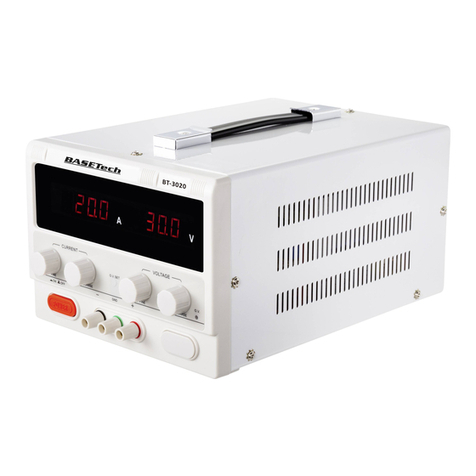
BASETech
BASETech BT-3020 operating instructions
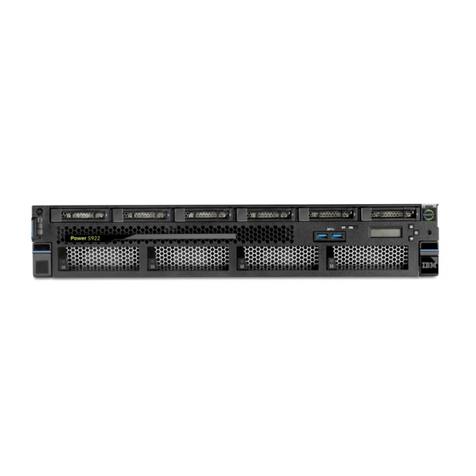
IBM
IBM 9008-22L manual

Ultra Products
Ultra Products ATX Power Supply user manual

nextys
nextys NCU120-12 instruction manual
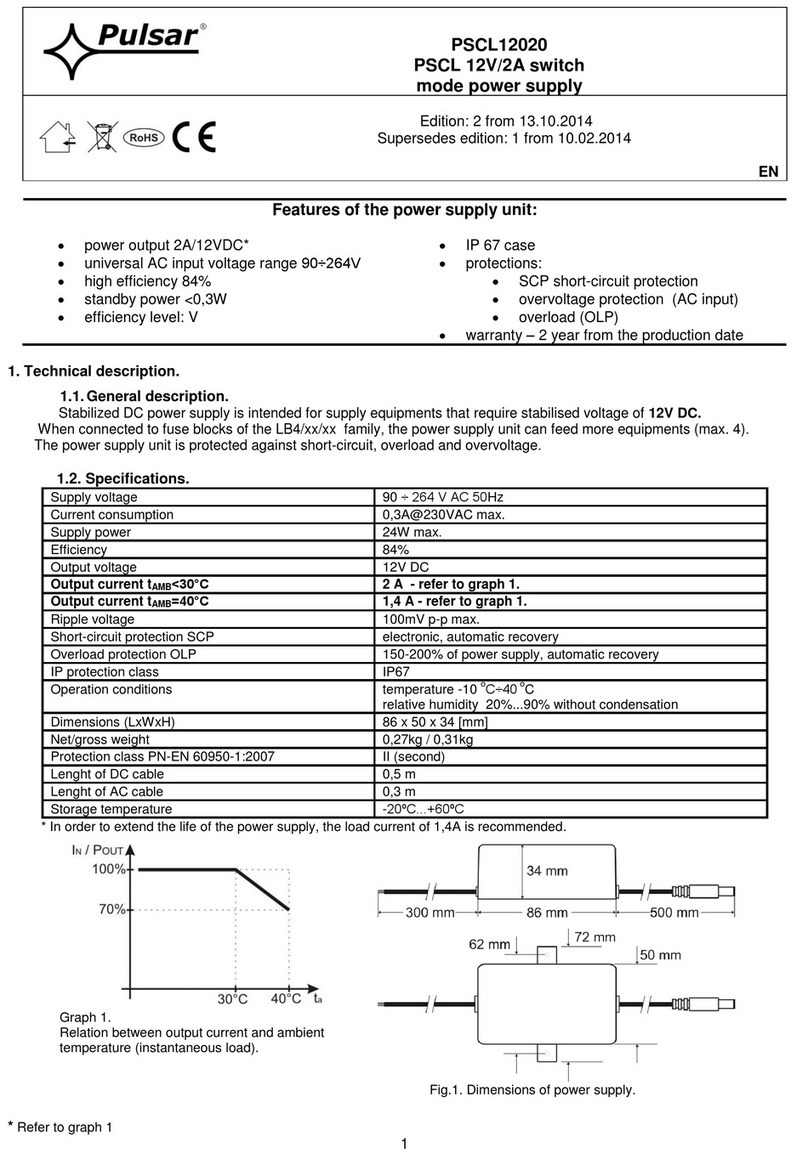
Pulsar
Pulsar PSCL12020 quick start guide
